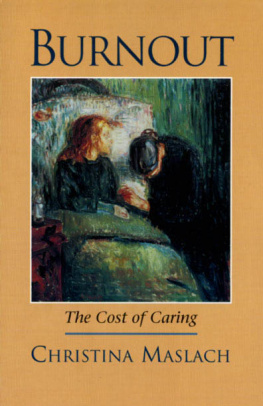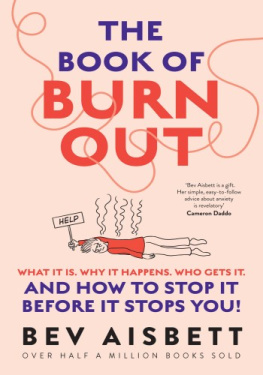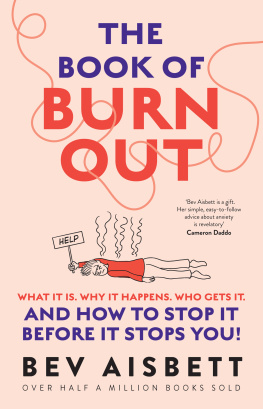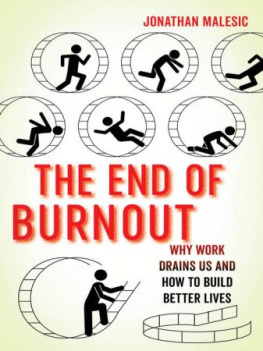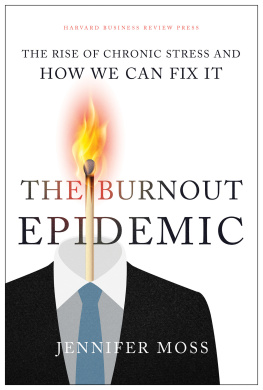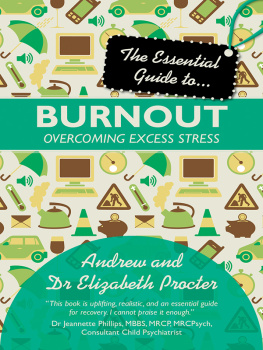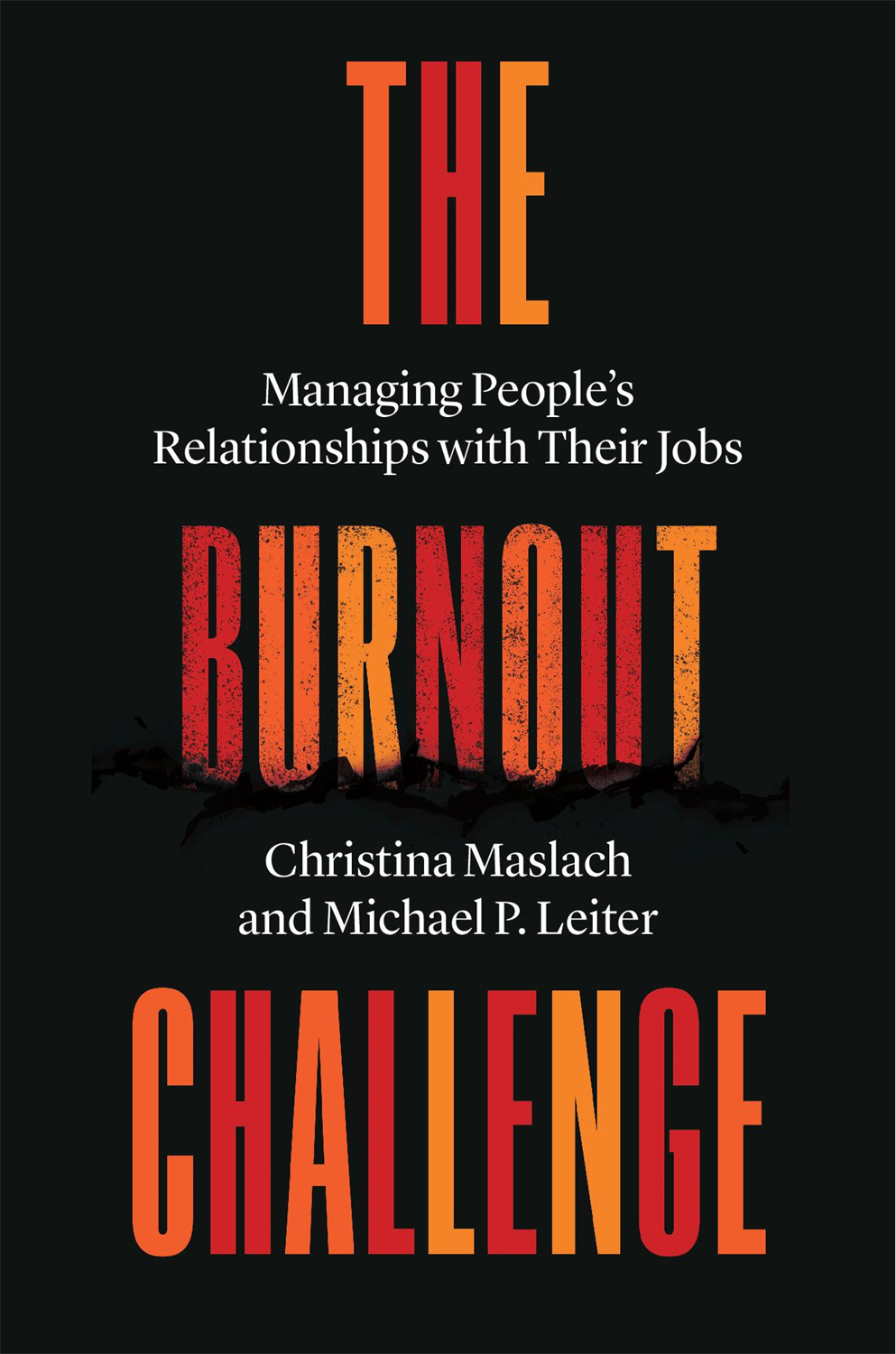Contents
Guide
Pagebreaks of the print version
THE BURNOUT CHALLENGE
Managing Peoples Relationships with Their Jobs
Christina Maslach and Michael P. Leiter
HARVARD UNIVERSITY PRESS
Cambridge, Massachusetts
London, England
2022
Copyright 2022 by the President and Fellows of Harvard College
All rights reserved
978-0-674-25101-4 (hardcover)
978-0-674-28730-3 (EPUB)
978-0-674-28729-7 (PDF)
Jacket design: Matt Avery
The Library of Congress has cataloged the printed edition as follows:
Names: Maslach, Christina, author. | Leiter, Michael P., author.
Title: The burnout challenge : managing peoples relationships with their jobs / Christina Maslach and Michael P. Leiter.
Description: Cambridge, Massachusetts : The Belknap Press of Harvard University Press, 2022. | Includes bibliographical references and index.
Identifiers: LCCN 2022001811
Subjects: LCSH: Burn out (Psychology). | Industrial management. | Success in business.
Classification: LCC BF481 .M3845 2022 | DDC 158/.7dc23
LC record available at https://lccn.loc.gov/2022001811
We dedicate this book to all those people who told us their stories, shared their experiences, answered our questions, and thus shone a bright light on burnout.
Contents
Across most of the twentieth century, in coal mines around the world, miners took caged canaries underground with them to test the air quality. The canarys high sensitivity to carbon monoxide and other toxic gases meant that, if it swayed on its perch, or even collapsed, the coal miners were forewarned in sufficient time to get out.
The practice was ended by the 1990s, but to stretch the metaphor lets say our hope was to keep more birds singing in mines. What would be our best approach? Should we try fixing the canary to make it stronger and more resilienta tough old bird that could take whatever conditions it faced? Or should we fix the mine, clearing the toxic fumes and doing whatever else necessary to make it safe for canaries (and miners) to do their work?
In recent Gallup polls, majorities of American workers rate their jobs as mediocre or bad.
Apparently, for entirely too many people, work is an unpleasant place of cynicism and despair, and something to be endured rather than a source of satisfaction or pride. Our own research has included many conversations with a broad spectrum of workers about their workplaces. Here are comments representative of the discontent and frustration weve heard:
From a physician: I gave 110 percent for many years only to find myself exhausted, bitter, and disillusioned. If I could do another profession with my medical degree, I would. I would advise my children to avoid medicine.
From a tech worker: I love my work. I am an avid learner and a very positive person. But I work in a socially toxic workplace. This is a highly political environment that encourages competition between colleagues, backstabbing, gossiping, and hiding information. I find going to work very difficult and I come home exhausted.
From an engineer: A large problem is that the company is always moving in new directions, and this is done in secret without receiving input from the professionals who actually perform the jobs. It makes us feel devalued when changes are made to a department or program, but the staff is never consulted or asked what could be done to improve their job.
There is a paradox here. Organizations ideals and employees experiences are disconnected, even at odds with one another. At a time when leaders extol the virtues of respectful workplaces and engaging teamwork, complaints of incivility, abuse, and bullying run rampant. Even as consultants and managers incessantly beat the drum of engagement, dissatisfaction remains an intense concern, including in the professions offering the greatest possibilities for vibrant, dedicated, absorbing work. Everywhere, there are thoughtful leaders deeply concerned with helping their employees be productive, fulfilled, and healthyand there is proof that some of what they do makes a difference. But the evidence also shows that, all too often, their efforts fall short of the mark.
Various social, political, and economic factors have shaped the work environment such that many jobs are increasingly stressful. Competitive pressures to cut costs and increase profits have resulted in downsizing, for example, leaving smaller staffs to manage the same workloads. In some sectors, changing public policiesand in health care, the rise of managed carehave strongly affected what customer-facing workers can provide and what they cannot. For many kinds of work, real wages have declined, and job benefits have been cut back. The result is a fundamental contradiction in the workplaces of the twenty-first century. On the one hand, organizations increasingly need the creativity and involvement of their employees. On the other hand, organizations have made changes that undermine peoples capacity to be engaged in their work.
Burnout
The negative impact of these workplace trends creates an employee experience of a crushing exhaustion, feelings of cynicism and alienation, and a sense of ineffectivenessthe triumvirate known as burnout. The burnout syndrome occurs when people experience combined crises on all three of these dimensions, most of the time. They feel chronically exhausted; they have withdrawn mentally, socially, and emotionally from their work; and they have lost confidence in their capacity to have a constructive impact. Basically, this means that they are experiencing high stress, a hostile job environment, and a pessimistic evaluation of themselves. Burnout is an apt term, suggesting a once-hot fire that has been reduced to ashes: those ashes are the feelings of exhaustion and a lack of engagement left after an initial, internal flame of dedication and passion is extinguished. The accelerants are the workplace conditions creating too-hot environments and leaving behind this trifecta with its scorching effects on peoples lives.
Burnout is also not a new term. Indeed, it has been part of the popular vocabulary for the better part of a century, and perhaps even longer. (Googles Ngram viewer charts its rise from a starting point in the 1820s.) The concept of the human stress response to difficult life events (stressors) was developed in the 1950s.
By the 1970s, workers in various realms of health and human services were using burnout to describe their own job crisis. One of us (Maslach), conducting interviews with such workers for a research project, heard the term repeatedly along with the stories behind itand soon shifted the project to focus on burnout instead. Since the latter came out in 1997, we have conducted studies in numerous organizations, tracking the development of job burnout, finding ways of reversing it, and nudging people toward engagement instead. Clearly, understanding burnout has been a major focus of our lives work. In this book, we pull all of it together into an integrated perspective on burnout and what to do about it.
In 2019, the World Health Organization (WHO) recognized burnout as a legitimate occupational phenomenon that could have a negative impact on the well-being of workers in the workplace. In its words:
Burn-out is a syndrome conceptualized as resulting from chronic workplace stress that has not been successfully managed.
It is characterized by three dimensions:
- feelings of energy depletion, or exhaustion.


